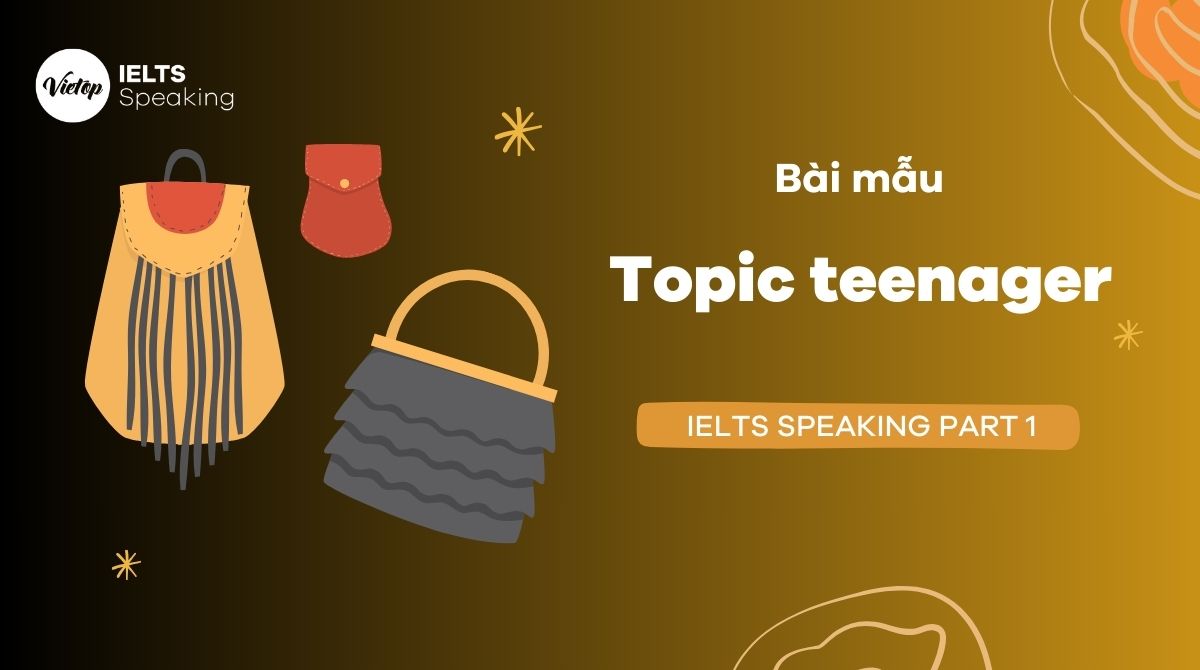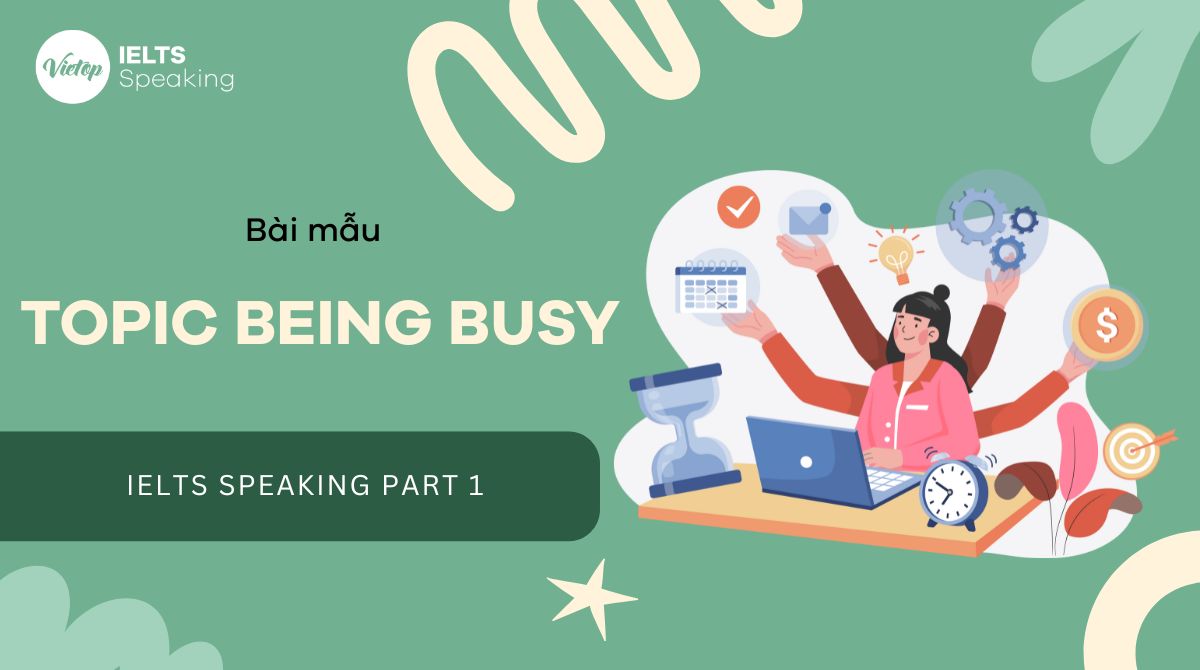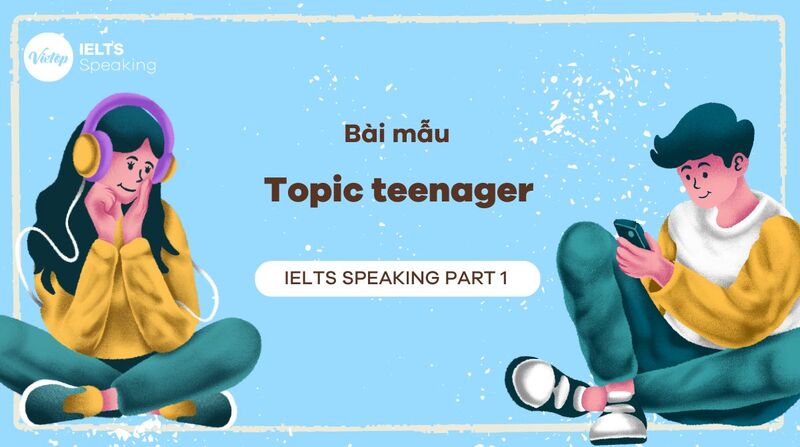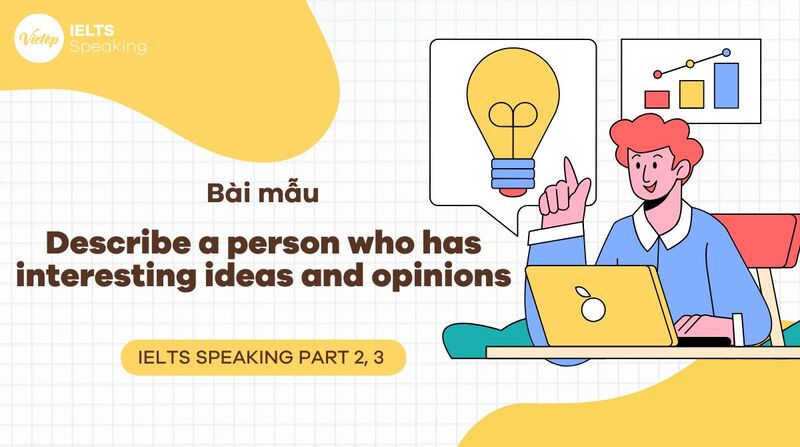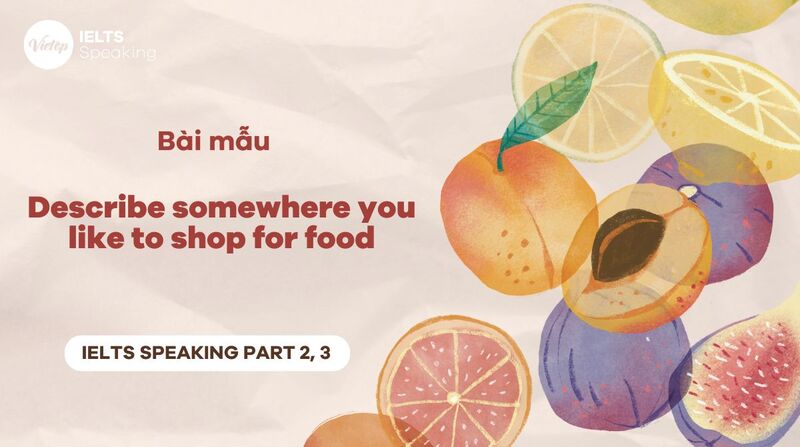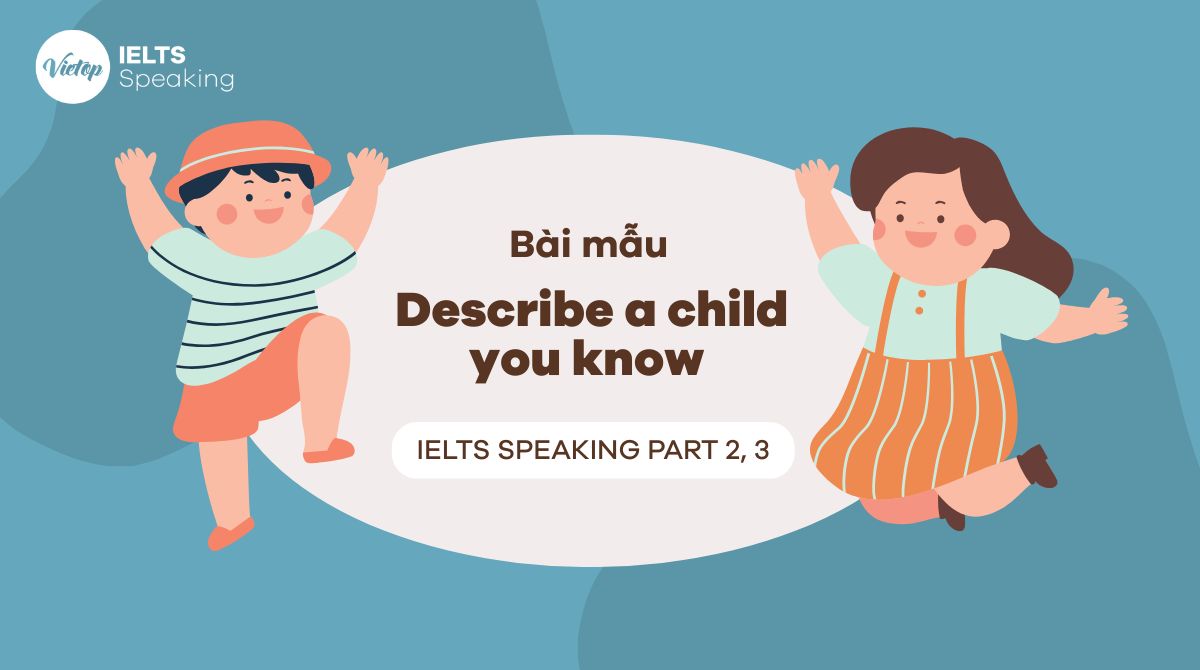Và phần chia sẻ tiếp theo Vietop English gửi đến bạn là topic Clothes – Bài mẫu IELTS Speaking part 1, 2, 3. Hãy cùng theo dõi từ vựng và cách triển khai ý chi tiết nhé!
Từ vựng tiếng Anh chủ đề quần áo (Clothes) chắc hẳn các bạn đang quan tâm những từ nào thường xuyên hay sử dụng trong các bài thi IELTS hoặc ngay trong cuộc sống hằng ngày. Các bạn hãy “note” lại ngay để có thể ghi nhớ nhanh chóng, khi gặp trong các bài thi tiếng Anh dễ dàng áp dụng nhanh nhất nhé.
1. Từ vựng chủ đề Clothes
- Accessory (n): phụ kiện
- Boutique (n): cửa tiệm quần áo bán lẻ
- Flea market : hội chợ
- Garment: quần áo
- Fabric: chất liệu vải
- Outfit: trang phục
- Dress up (v): ăn mặc đẹp cho dịp gì đó
- Go out of style: ăn mặc lỗi thời
- In vogue = fashionable
- Casual (a): giản dị, mặc hằng ngày
- Formal (a): trang trọng
- Elegant (a): lịch sự
- Trendy (a): hợp thời
- Affordable (a): giá cả hợp lý
- Authentic clothes >< Replica: hàng chính hãng >< hàng nhái y hàng thật
- Fit like a glove (idiom): vừa vặn
- The in thing = fashionable
- Uniform (n) đồng phục
- Sportswear (n): phong cách qần áo thể thao
- Menwear (n) phong cách nam tính (dành cho nữ)
- Minimal (a): thuộc phong cách tối giản
- Customers: khách hàng
- Dress codes (n): quy định về trang phục
- Designed clothing: trang phục thiết kế
- Throw-away society: xã hội có xu hướng sử dụng hàng hóa phung phí (sử dụng vài lần rồi bỏ)
- Throw money at: vung tiền vào…
Xem ngay: Khóa học IELTS Online – Online trực tuyến cùng chuyên gia IELTS 8.5
2. Một số chủ đề liên quan đến Clothes
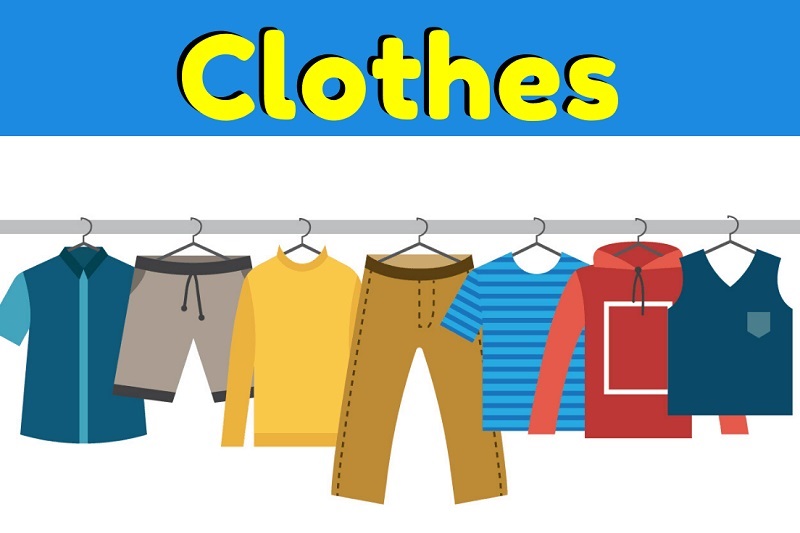
2.1. About clothes
Your type of clothes can inform passersby about whom you are such as your ambitions, characteristics and spending habits: Loại quần áo của bạn có thể cho mọi người thấy bạn là ai cụ thể như tham vọng, tính cách và thoái quen tiêu xài của bạn.
=> People usually make judgements about others from the clothes they wear. (Mọi người thường phán xét người khác thông qua những gì họ mặc).
In the past, clothes used to be colorful. Trong quá khứ, quần áo thường có màu sắc sặc sỡ.
=>Tend to wear traditional clothes very often. (Có xu hướng mặc đồ truyền thống thường xuyên).
In the present, due to globalization, people seem to change their style into jeans and tee-shirts to be more comfortable and modern. (Hiện tại, vì toàn cầu hóa, mọi người có vẻ thay đổi phong cách của họ sang quần jean và áo thun để thoải mái và hiện đại hơn).
In the future, the style may change again. (Trong tương lai, phong cách sẽ thay đổi một lần nữa).
- => Be more versatile (Đa chức năng, linh hoạt.)
- => Jumpsuits may be universal. (Áo liền quần có thể sẽ phổ biến).
2.2. Trends
Wear newest designed/ branded clothes from head to toe. (Mặc quần áo thiết kế/ hàng hiệu từ đầu đến chân).
- => Confirm one’s social status (be wealthy and stylish), create branding image. (Khẳng định vị thế của 1 người (giàu có và phong cách), xây dựng thương hiệu cá nhân).
- => Create a good impression. (Tạo ấn tượng tốt).
Cost a fortune/ cost an arm and a leg: tốn nhiều tiền
=> Overspend (tiêu tiền quá mức) money on clothes, shoes, accessories
- Have to follow new trends all the times. (Lúc nào cũng phải chạy theo xu hướng).
=> Squander (hoang phí) both clothes and money
Xem thêm về:
Talk about Tet holiday in Viet Nam
Topic Describe A Famous Person – IELTS Speaking Part 2
2.3. Uniforms
Advantages
- Help potential customers identify your business – create a brand awareness: giúp khách hàng tiềm năng xác định được kinh doanh của bạn – tạo ra nhận thức về thương hiệu
- Make your employees feel they are part of a team → foster a sense of pride → greater success + increased employee loyalty → improve team building and unity: làm cho nhân viên của bạn cảm thấy → họ là một phần của một nhóm → nuôi dưỡng cảm giác tự hào → thành công lớn hơn + tăng lòng trung thành của nhân viên → cải thiện việc xây dựng đội nhóm và đoàn kết
- Create a professional business image: tạo ấn tượng tốt → tạo hình ảnh doanh nghiệp chuyên nghiệp
- Everyone feels equal: mọi người đều cảm thấy như nhau (không ai hơn ai)
- Eliminate any issues of an individual dressing inappropriately for the job: loại bỏ bất kỳ vấn đề của một cá nhân ăn mặc không phù hợp cho công việc
- Protect workers → areas such as construction/ healthcare/security → uniforms → require specialist technologies and fabrics/ specific accessories (helmets, …): bảo vệ công nhân → các lĩnh vực như xây dựng / chăm sóc sức khỏe / an ninh → đồng phục → yêu cầu các công nghệ và vải chuyên biệt/ phụ kiện (mũ bảo hiểm)
- Dress codes may discourage sexual harassment in the workplace: quy định về trang phục có thể → hạn chế được vấn đề quấy rối tình dục ở nơi làm việc
- Save time → don’t need to spend time worrying about what to wear/ figuring out the right mix of…: tiết kiệm thời gian → không cần dành thời gian lo lắng về việc mặc gì / tìm ra cách phối đồ … với đồ …
Disadvantages
- Stifle creativity → curtail the freedom of employees → difficult to express themselves: kìm hãm sự sáng tạo → hạn chế tự do của nhân viên → khó thể hiện bản thân
- Feel uncomfortable (feel uncomfortable wearing standardised clothing/ high heels,…): cảm thấy không thoải mái (cảm thấy không thoải mái khi mặc quần áo may sẵn / giày cao gót, …)
- Poorly designed work clothes → restrict performance: quần áo làm việc được thiết kế kém → hạn chế hiệu suất làm việc.
Bạn muốn học tiếng Anh giao tiếp chuẩn quốc tế? Với giáo trình National Geographic Learning, khoá học Speaking Listening tại Vietop giúp bạn tiếp cận phương pháp học hiện đại, phù hợp với tiêu chuẩn quốc tế.
2.4. Factors for choosing clothes
- The place/area where we live (you come from urban or rural areas): địa điểm/ khu vực nơi chúng ta sống (bạn đến từ thành thị hoặc nông thôn)
- Occasions (daily wear – jeans and T-shirts, or special occations – dresses and high heels): những dịp khác nhau (đồ mặc hàng ngày – quần jean và áo phông, hoặc những dịp đặc biệt – váy và giày cao gót)
- Income (rich → fashionable garments, poor/low income → durable clothes): thu nhập (giàu → đồ thời trang, nghèo / thu nhập thấp → quần áo bền – mặc được lâu)
- Seasons (winter → sweater, coats, long-sleeved T-shirts, summer → shorts, tank tops,…): mùa (mùa đông → áo len, áo khoác, áo phông dài tay, mùa hè → quần short, áo tank top,)
- Age (adolescents → clothes with bright colours): tuổi tác (thanh thiếu niên → quần áo với màu sắc tươi sáng)
- Location: boutiques / outlets: các cửa hàng bán lẻ. Department stores / malls: cửa hàng trong trung tâm thương mại → buy high-quality products. Flea markets: hội chợ → cheaper. Online: trực tuyến
Xem thêm:
Các chủ đề thường gặp ở phần thi IELTS Speaking Part 3
Các dạng câu hỏi trong IELTS Speaking Part 3 thường gặp
Bài mẫu Talk about your hobbies
3. Bài mẫu IELTS Speaking part 1 Topic Clothes
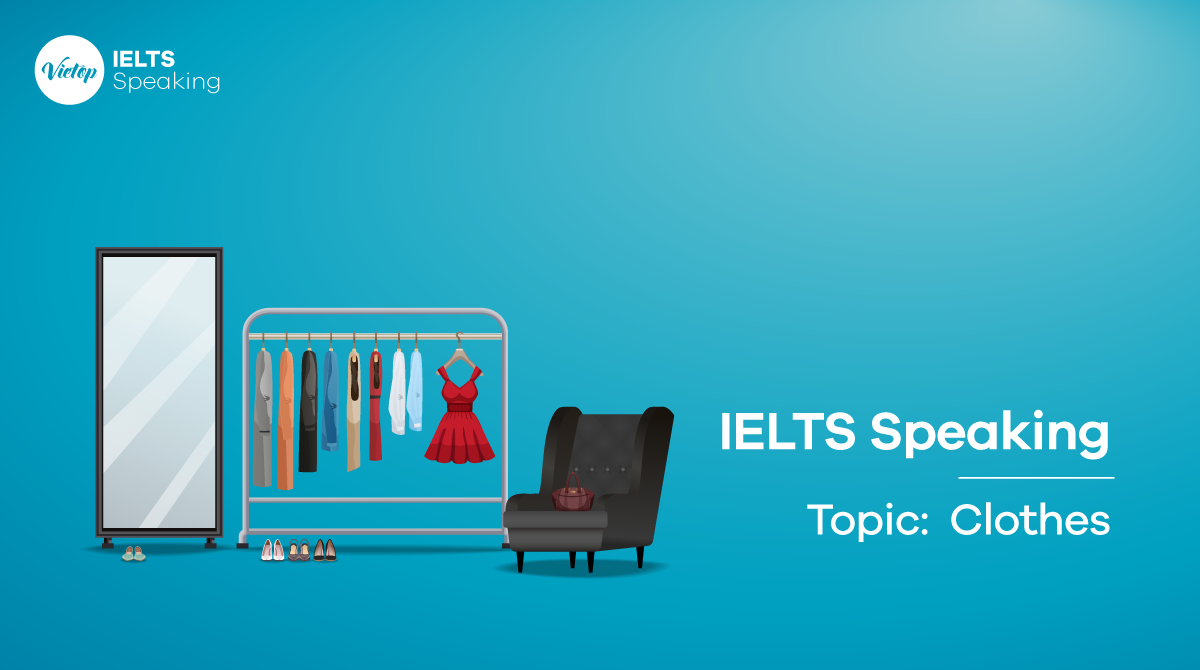
Mời mọi người cùng nghe Audio Topic Clothes part 1 tại đây nhé!
3.1. Do you enjoy buying clothes?
Yes, I do enjoy buying clothes, but not as much as some people do. I usually shop for clothes when I need something specific or when I come across a good sale. I also enjoy browsing through shops and trying on different styles from time to time.
- Enjoy (v): thích, tận hưởng
- Not as much as (phrase): không nhiều như
- Specific (adj): cụ thể, đặc biệt
- Good sale (adj + n): giảm giá tốt
- Browsing (v): duyệt qua, tìm kiếm
- Trying on (v + phrasal verb): thử (quần áo)
- From time to time (phrase): thỉnh thoảng, đôi khi
3.2. What type of clothes do you like/don’t like to wear?
I tend to prefer casual and comfortable clothes such as jeans, t-shirts, and sneakers. I also like clothes that are versatile and can be dressed up or down depending on the occasion. I’m not really into high fashion or designer brands, so I usually opt for affordable and practical clothes that I can wear on a daily basis.
- Prefer (v): ưa thích, thích hơn
- Casual (adj): thường ngày, bình thường
- Comfortable (adj): thoải mái, dễ chịu
- Versatile (adj): linh hoạt, đa năng
- Dressed up (phrasal verb): trang trọng hơn
- Dressed down (phrasal verb): giản dị hơn
- Occasion (n): dịp, sự kiện
- High fashion (n): thời trang cao cấp
- Designer brands (n): nhãn hiệu thiết kế
- Opt (v): chọn
- Affordable (adj): giá hợp lý
- On a daily basis: hằng ngày
Bạn muốn cải thiện kỹ năng Speaking với những tips và chiến thuật trả lời giúp ghi điểm với ban giám khảo. Khoá học IELTS 3.0 – 5.0 của Vietop English – nơi mang đến cho bạn lộ trình học cá nhân hoá, không chỉ tự tin chinh phục ban giám khảo trong phòng thi mà còn vận dụng được kiến thức thật trong đời sống thực tế.
3.3. Do you think the brand of clothing is important?
Personally, I don’t think the brand of clothing is very important. What matters more to me is the quality and style of the clothes. Of course, some people may value certain brands for their reputation or prestige, but for me, it’s not a deciding factor. I’d rather spend my money on clothes that I genuinely like and will wear often, regardless of the brand.
- Personally (adv): cá nhân tôi
- Quality (n): chất lượng
- Style (n): phong cách
- Reputation (n): danh tiếng
- Prestige (n): uy tín, thanh thế
- Deciding factor (n + n): yếu tố quyết định
- Genuinely (adv): thành thật, chân thành
- Regardless of (prep): bất kể
3.4. What kind of clothes do people in your country usually wear?
In Vietnam, we usually wear traditional clothes for special occasions, such as the áo dài or áo tấc, áo ngũ thân,… For everyday wear, the styles can vary depending on the region and personal preference. But I can say that in general, people tend to wear casual and comfortable clothes, such as t-shirts, jeans, and sneakers. However, recently there is also a growing trend of wearing more trendy and fashionable clothes.
- Traditional (adj): truyền thống
- Special occasions (n): dịp đặc biệt
- Everyday wear (n): trang phục hàng ngày
- Vary (v): thay đổi, khác nhau
- Region (n): khu vực
- Casual (adj): thường ngày, bình thường
- Comfortable (adj): thoải mái, dễ chịu
- Growing trend (n + n): xu hướng phát triển
- Fashionable (adj): thời trang
3.5. Do you wear different styles of clothes now compared to 10 years ago?
Yes. When I was younger, I used to wear more colorful and flashy clothes, but as I’ve gotten older, my style has become more understated and minimalistic. Nowadays, I prefer neutral colors and simple designs that are easy to mix and match. I also prioritize comfort and quality over trendiness.
- Understated (adj): kín đáo, không thịnh hành
- Minimalistic (adj): tối giản, đơn giản
- Neutral colors (adj + n): màu trung tính
- Simple designs (adj + n): thiết kế đơn giản
- Mix and match (v + v): phối đồ
- Prioritize (v): ưu tiên
- Comfort (n): sự thoải mái
- Quality (n): chất lượng
- Trendiness (n): tính thịnh hành
3.6. Do your friends wear the same kinds of clothes as you?
My friends and I have different styles of clothes, although there may be some overlap in terms of certain preferences. Some of my friends are more fashion-conscious and like to wear trendy clothes, while others prioritize comfort and practicality. As for me, I tend to prefer simple and versatile clothes that can be worn on almost every occasion.
- Overlap (n): sự trùng khớp
- Fashion-conscious (adj): quan tâm đến thời trang
- Trendy (adj): thịnh hành, theo xu hướng
- Prioritize (v): ưu tiên
- Practicality (n): tính thực tiễn, hữu dụng
- Versatile (adj): đa năng, linh hoạt
3.7. Do you think the clothes we wear say something about who we are?
I think the clothes we wear can say something about us, but it’s not always an accurate reflection of our personality or character. Clothing is a form of self-expression, and we may choose to wear certain styles or brands based on our personal preferences or external factors. Nevertheless, it’s important to remember that our clothing choices do not define us as individuals.
- Self-expression (n): sự biểu hiện của bản thân
- Personal preferences (adj + n): sở thích cá nhân
- External factors (adj + n): yếu tố bên ngoài
- Define (v): xác định, định nghĩa
- Individuals (n): cá nhân
Xem thêm:
Describe a person you wanted to be similar to when you were young
4. Bài mẫu IELTS Speaking part 2 topic clothes
4.1. Describe a piece of clothing you like
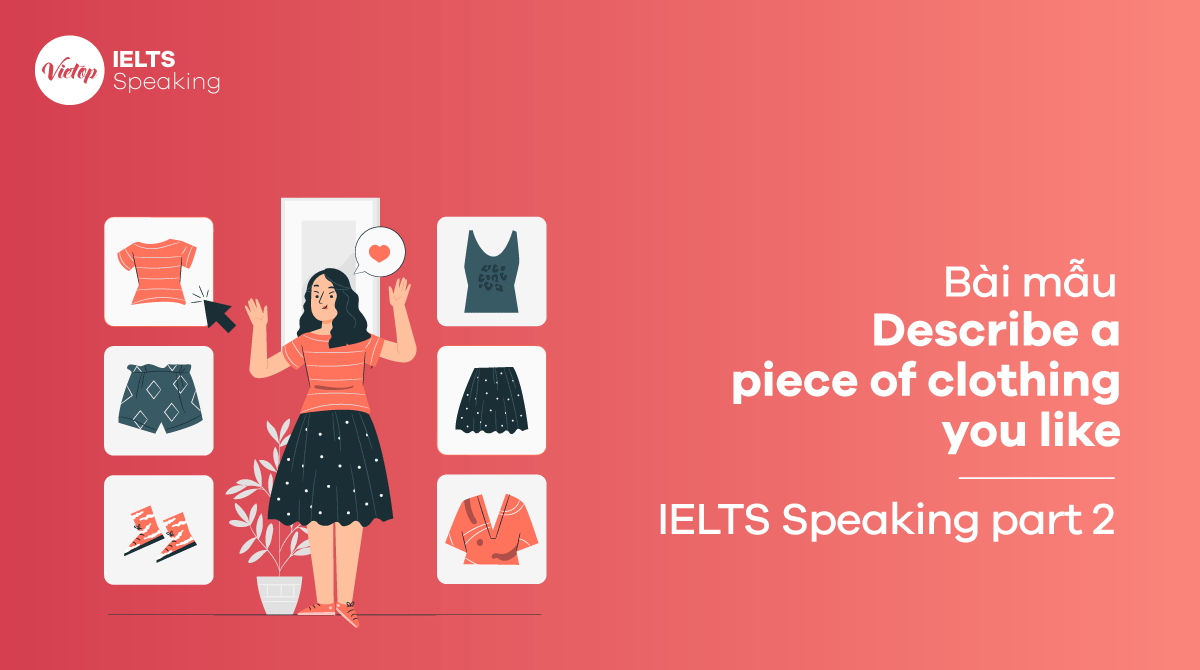
Mời mọi người cùng nghe Audio Topic Clothes part 2 – Describe a piece of clothing you like tại đây nhé!
Describe a piece of clothing you like to wear. You should say:
- Where you bought it
- How often you wear it
- What it is like
- Explain why you enjoy wearing it
Bài mẫu
So I’m going to tell you about one of the clothing items I enjoy wearing, which is my black leather jacket that I purchased from a high-end fashion store in the city center about 2 years ago. It was on sale that time, if I remember correctly, so I bought it at an affordable price.
The jacket has a classic design with a simple collar and zipper closure, making it easy to pair with any outfit. I find it to be a versatile piece of clothing that can be dressed up or down depending on the occasion. It goes well with jeans and a t-shirt for a casual look or can be paired with a dress for a more formal event. The timeless design of the jacket also means that it will never go out of style.
In addition to its stylish appearance, I appreciate the practicality of the jacket. It has several pockets, which come in handy for storing my phone, keys, or wallet. The leather material is also easy to clean and maintain, so I don’t have to worry about it getting dirty or stained.
This black leather jacket, therefore, is a wardrobe staple that I will continue to wear and enjoy for years to come.
- Leather jacket (n): áo khoác da
- High-end fashion store (n): cửa hàng thời trang cao cấp
- Collar (n): cổ áo
- Zipper closure (n): khóa kéo
- Versatile (adj): đa năng
- Occasion (n): dịp
- Timeless (adj): vượt thời gian
- Stylish appearance (n + n): diện mạo bắt mắt
- Practicality (n): tính thực dụng
- Come in handy (idiom): hữu ích
- Maintain (v): bảo trì
- Stained (adj): bị vấy bẩn
- Wardrobe staple (n + n): trang phục cơ bản, không thể thiếu trong tủ quần áo
Bạn đã học tiếng Anh nhưng vẫn chưa thể giao tiếp tự nhiên? Tham khảo ngay khoá học Speaking Listening tại Vietop! Khoá học mang đến chương trình luyện tập chuyên sâu, giúp bạn phản xạ nhanh và phát âm chuẩn chỉ sau 19 buổi học.
4.2. Describe someone you know who dresses well
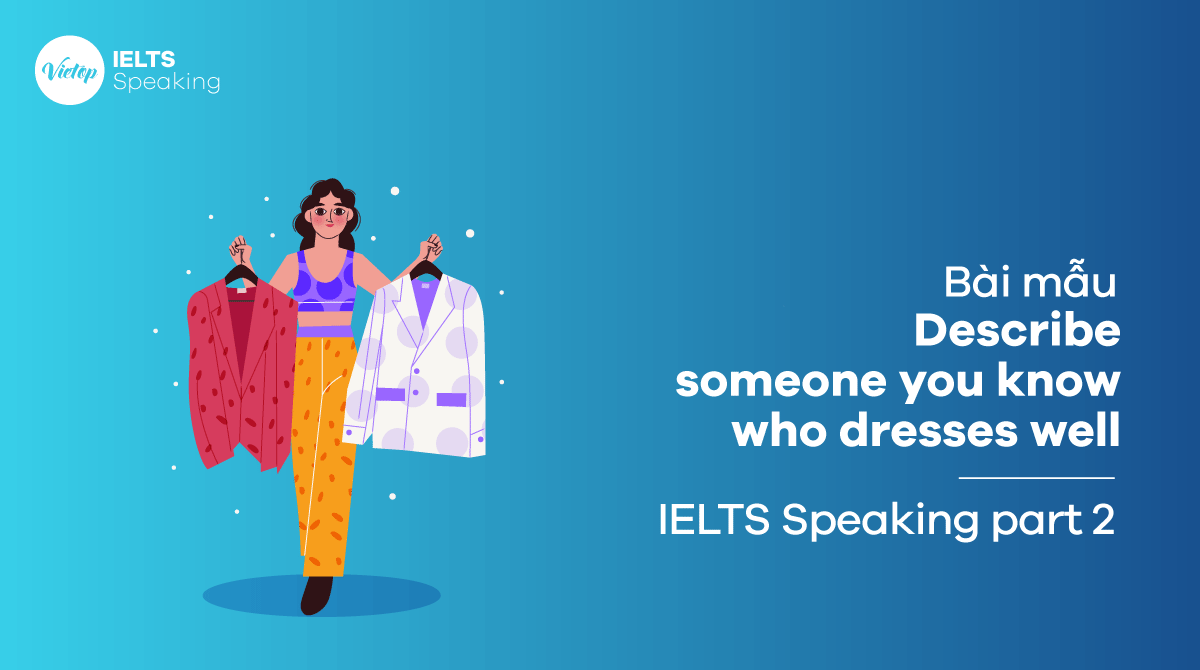
Mời mọi người cùng nghe Audio Topic Clothes part 2 – Describe someone you know who dresses well tại đây nhé!
Describe a person you know who dresses well. You should say:
- Who this person is
- What kinds of clothes this person likes to wear
- How you know this person
- And explain why you think this person dresses well
Bài mẫu
I would like to talk about my friend, Lumine, who always dresses impeccably. She has a great sense of style and knows how to put together outfits that are both fashionable and comfortable.
Lumine likes to wear a variety of clothes, but she leans towards classic and modern pieces. She often wears blouses or shirts paired with skinny jeans or tailored pants. She also loves to accessorize with scarves, earrings, and bracelets, which add a touch of elegance to her outfits. Her shoe collection is also impressive, with a range of stylish boots, flats, and heels.
I met Lumine through a mutual friend and we quickly became close. As we spent more time together, I noticed how she always looked put together, whether we were going out for a casual lunch or attending a formal event. She never seems to have a bad day fashion-wise, and her outfits always compliment her natural beauty.
I think Lumine dresses well because she knows what suits her body shape and personal style. She invests in high-quality pieces that are versatile and timeless, which means she can wear them for years to come. She also pays attention to details such as accessories and shoes, which elevate her outfits to the next level.
- Impeccably (adv): hoàn hảo, không tì vết
- Sense of style (n): gu thẩm mỹ
- Fashionable (adj): thời trang
- Accessorize (v): trang trí
- Bracelets (n): vòng tay
- Stylish (adj): sang trọng
- Mutual friend (n): người bạn chung
- Put together (phrasal verb): kết hợp
- Complement (v): bổ sung, hoàn thiện
- Body shape (n): dáng người
- Personal style (n): phong cách cá nhân
- Invest (v): đầu tư
- High-quality (adj): chất lượng cao
- Versatile (adj): đa năng
- Elevate (v): nâng cao
Xem thêm:
5. Bài mẫu IELTS Speaking part 3 topic clothes
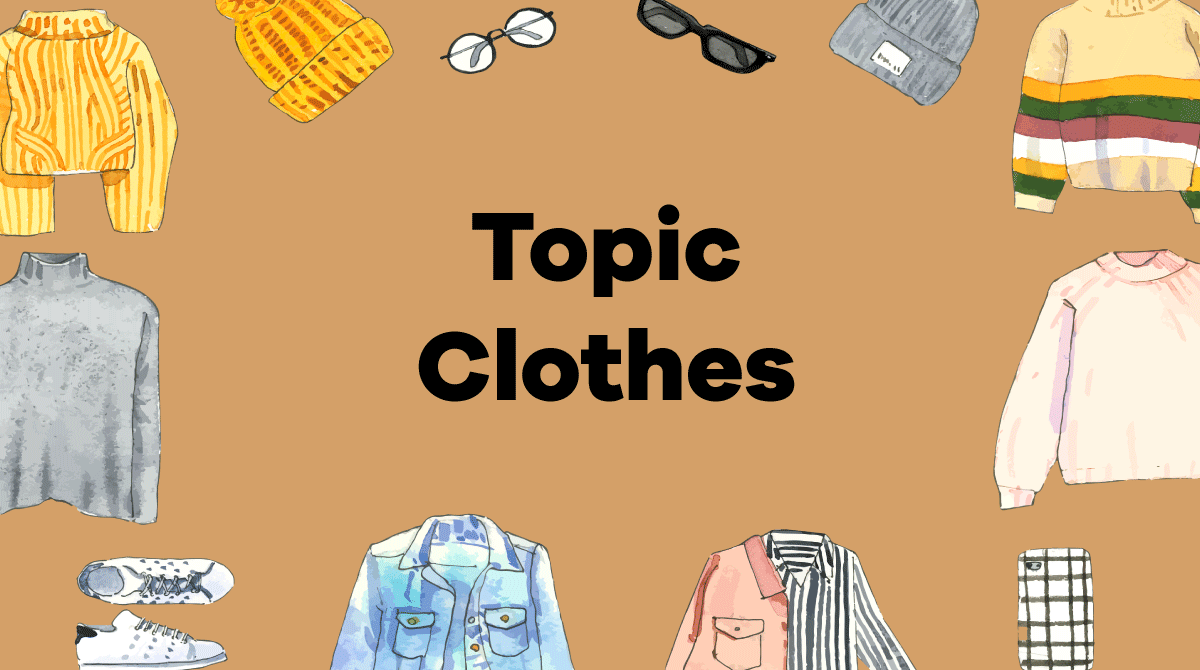
Mời mọi người cùng nghe Audio Topic Clothes part 3 tại đây nhé!
5.1. Is it possible to look good without spending lots of money on clothes?
My answer is yes. It is definitely possible to look stylish and fashionable without having to spend a lot of money on clothing. One can achieve this by choosing pieces that can be mixed and matched with other items in their wardrobe. Another option is to shop at thrift stores or secondhand shops, where one can find affordable yet fashionable clothing. It’s important to know what styles and colors suit your body shape and personal taste, and to choose clothes that make you feel comfortable and confident.
- Achieve (v): đạt được
- Pieces (n): món đồ
- Wardrobe (n): tủ quần áo
- Thrift stores (n): cửa hàng bán đồ cũ
- Secondhand shops (n): cửa hàng đồ cũ
- Affordable (adj): giá cả phải chăng
- Colors (n): màu sắc
- Body shape (n): dáng người
- Personal taste (n): sở thích cá nhân
- Comfortable (adj): thoải mái
- Confident (adj): tự tin
5.2. Do fashion shows have an impact on what we are wearing?
I do agree with that. They set the latest trends and influence the fashion industry as a whole. Fashion designers showcase their new collections on the runway, which are then picked up by influencers and celebrities. Eventually, these trends make their way into mainstream fashion and become popular among the general public. So I think that these shows play a crucial role in shaping the way we dress and express ourselves through fashion.
- Trends (n): xu hướng
- Influence (v): ảnh hưởng
- Fashion industry (n): ngành công nghiệp thời trang
- Showcase (v): trưng bày
- Collections (n): bộ sưu tập
- Runway (n): sàn diễn
- Influencers (n): người tạo ảnh hưởng
- Celebrities (n): người nổi tiếng
- Mainstream fashion (n): thời trang phổ thông
- Popular (adj): phổ biến
- General public (n): công chúng
5.3. Do you think fashion trends have changed constantly?
My answer would be a big yes. What was fashionable a few decades ago may not be popular now. Fashion is always evolving, and designers are constantly creating new styles and trends. The rise of social media has also played a significant role in shaping fashion trends, with influencers and bloggers driving new trends and styles. However, to me, some classic styles, such as the little black dress, have remained popular over time.
- Fashionable (adj): thời trang
- Evolving (v): tiến hóa
- Designers (v): nhà thiết kế
- Social media (n): mạng xã hội
- Bloggers (v): những người viết blog, tạo content
- Drive (v): thúc đẩy
- Classic (adj): cổ điển
- Little black dress (n): váy đen đơn giản
5.4. Do you think people behave differently in different kinds of clothes?
In my view, clothing can affect a person’s mood and even behavior. For example, wearing formal attire can make one feel more professional and confident, while wearing casual clothes can make a person feel more relaxed and comfortable. Therefore, I would agree that clothing can also reflect a person’s personality and cultural background.
- Affect (v): ảnh hưởng
- Mood (n): tâm trạng
- Behavior (n): hành vi
- Formal attire (n): trang phục trang trọng
- Professional (adj): chuyên nghiệp
- Relaxed (adj): thoải mái
- Reflect (v): phản ánh
- Personality (n): tính cách
- Cultural background (n): nền văn hoá
6. Bài tập luyện Topic Clothes
- Do all people enjoy shopping for clothes?
- Why women like to do shopping?
- Why some women buy cheaper clothes and expensive ones at the same time?
- Do you think it is good for people buy expensive clothes? Why?
- Why do some people like shopping with friends?
- Why people like shopping for clothes online?
- What risks would take when shopping online? Why?
- What special clothes do people in your country wear on official or formal occasions?
- What is the different dress style between boys and girls?
Luyện tập IELTS Speaking với bài mẫu IELTS Speaking part 2 và IELTS Speaking part 3 nhé!
Trên đây là 1 số các từ vựng tiếng Anh topic Clothes thường hay gặp nhất trong các bài thi tiếng Anh và cuộc sống hằng ngày, thậm chí xuất hiện nhiều trong một số phần bài thi tiếng Anh IELTS Speaking và mẫu câu để triển khai chủ đề Clothing IELTS Speaking Part 3.
Các bạn cần lưu ý và ghi nhớ kỹ lại và chúc các bạn thành công trong quá trình học tập ôn luyện thi tiếng Anh IELTS nhé!

